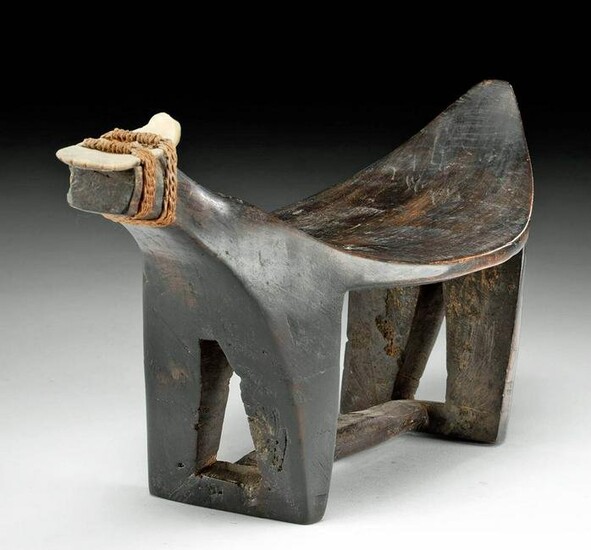19th C. Micronesian Wood Coconut Grater (Child Size)
Oceania, Polynesia, Micronesia, Caroline Islands, Nukuoro Island, ca. late 19th to early 20th century CE. A beautiful example of a hand-carved wooden stool for a child used for grating coconut, presenting a stylized zoomorphic form with a sloped, petaloid seat supported by 2 thick, openwork legs with a single stretcher and a serrated piece of white shell attached to the front using woven plant fibers. This item would have been used by rubbing a split coconut along the shell edge to shred the meat. The graceful stool is wonderfully minimalist, a style characteristic of the island, which is a remote coral atoll with a population of just under 400 people. Size: 12.3" L x 4.7" W x 6" H (31.2 cm x 11.9 cm x 15.2 cm)
According to "The Coconut in Micronesia" by Leo Migvar, "The coconut palm is the most important tree crop for the people of Micronesia and provides the major cash export - copra. It not only provides the money to buy sugar, salt, and clothes but also provides daily subsistence. If the palm were not present, most of the atolls would today be uninhabited." (Agricultural Extension Circular Number 3, Saipan, Mariana Islands: Trust Territory of the Pacific Islands, 1965)
Coconuts can be found on the continents of North and South America, Asia, and Africa. Valued for their milk, oil, and meat, coconuts are not only used in cooking and food prep, but also serve as a water source making them a popular item to take aboard ships for long voyages. This led to their worldwide distribution, which is notably not the result of their own migration or that of the African swallow.
Provenance: private Hawaii, USA collection, acquired from 1995 to 2010
All items legal to buy/sell under U.S. Statute covering cultural patrimony Code 2600, CHAPTER 14, and are guaranteed to be as described or your money back.
A Certificate of Authenticity will accompany all winning bids.
PLEASE NOTE: Due to recent increases of shipments being seized by Australian & German customs (even for items with pre-UNESCO provenance), we will no longer ship most antiquities and ancient Chinese art to Australia & Germany. For categories of items that are acceptable to ship to Australia or Germany, please contact us directly or work with your local customs brokerage firm.
Display stands not described as included/custom in the item description are for photography purposes only and will not be included with the item upon shipping.
#168531
Condition Report: Repairs to legs with light restoration over break lines. Expected nicks, chips, scratches, and abrasions, commensurate with age and use. Some light fraying to woven vegetal fibers. Otherwise, excellent with lovely patina throughout.
View it on
Estimate
Time, Location
Auction House
Oceania, Polynesia, Micronesia, Caroline Islands, Nukuoro Island, ca. late 19th to early 20th century CE. A beautiful example of a hand-carved wooden stool for a child used for grating coconut, presenting a stylized zoomorphic form with a sloped, petaloid seat supported by 2 thick, openwork legs with a single stretcher and a serrated piece of white shell attached to the front using woven plant fibers. This item would have been used by rubbing a split coconut along the shell edge to shred the meat. The graceful stool is wonderfully minimalist, a style characteristic of the island, which is a remote coral atoll with a population of just under 400 people. Size: 12.3" L x 4.7" W x 6" H (31.2 cm x 11.9 cm x 15.2 cm)
According to "The Coconut in Micronesia" by Leo Migvar, "The coconut palm is the most important tree crop for the people of Micronesia and provides the major cash export - copra. It not only provides the money to buy sugar, salt, and clothes but also provides daily subsistence. If the palm were not present, most of the atolls would today be uninhabited." (Agricultural Extension Circular Number 3, Saipan, Mariana Islands: Trust Territory of the Pacific Islands, 1965)
Coconuts can be found on the continents of North and South America, Asia, and Africa. Valued for their milk, oil, and meat, coconuts are not only used in cooking and food prep, but also serve as a water source making them a popular item to take aboard ships for long voyages. This led to their worldwide distribution, which is notably not the result of their own migration or that of the African swallow.
Provenance: private Hawaii, USA collection, acquired from 1995 to 2010
All items legal to buy/sell under U.S. Statute covering cultural patrimony Code 2600, CHAPTER 14, and are guaranteed to be as described or your money back.
A Certificate of Authenticity will accompany all winning bids.
PLEASE NOTE: Due to recent increases of shipments being seized by Australian & German customs (even for items with pre-UNESCO provenance), we will no longer ship most antiquities and ancient Chinese art to Australia & Germany. For categories of items that are acceptable to ship to Australia or Germany, please contact us directly or work with your local customs brokerage firm.
Display stands not described as included/custom in the item description are for photography purposes only and will not be included with the item upon shipping.
#168531
Condition Report: Repairs to legs with light restoration over break lines. Expected nicks, chips, scratches, and abrasions, commensurate with age and use. Some light fraying to woven vegetal fibers. Otherwise, excellent with lovely patina throughout.



